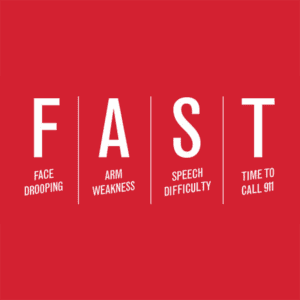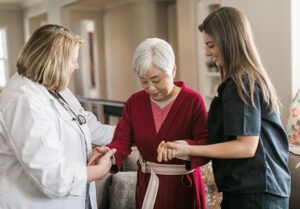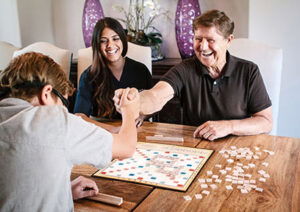A stroke can happen at any age but according to the Medical University of South Carolina, about 75 percent of strokes occur in people 65 or older. MUSC dubbed stroke as “the stalker of our aging population” yet notes that only about 18 percent of strokes are fatal – likely because the American Stroke Association and other organizations have taught us over the years to get immediate help when a stroke occurs. Given that many older adults and seniors survive a stroke, it has become the leading cause of long-term disability in the U.S.
May being American Stroke Month gives seniors and their families – and indeed, all of us – the opportunity to consider ways not only to understand and prevent strokes but also how to recover from one should it strike. As a provider of non-medical, in-home care, we at Amada Senior Care recognize the profound impact a stroke can have not only on the senior or older adult who experiences it but also on their family, friends and caregivers. A stroke is a significant life event that necessitates a journey of recovery, adaptation and resilience. The road to recovery can be challenging, yet with the right support and resources, life after a stroke can still be fulfilling and meaningful.
Understanding Stroke in Seniors
Defined as a “brain attack,” a stroke happens when the brain’s blood supply is halted by a blockage or clot, leading to the death of brain cells in the affected area due to oxygen deprivation or damage from sudden bleeding. Swift treatment can save those cells at risk.
Ischemic strokes, constituting the majority of stroke cases, are triggered by blood clots obstructing the vessel that supplies blood to the brain. These clots can arise within the brain or neck’s blood vessels (thrombosis), move from another body part (embolism), or result from artery narrowing due to fatty deposits (stenosis). The second form, hemorrhagic or intracerebral hemorrhage (ICH), occurs when a blood vessel bursts and bleeds into the brain, often due to weak artery walls or ruptures caused by fatty deposits.
Signs of Stroke and the Need to ACT FAST
A stroke occurs when the blood supply to part of your brain is interrupted or reduced, preventing brain tissue from getting oxygen and nutrients. This can lead to brain cells dying in minutes, which is why it is crucial to recognize the signs of a stroke and seek immediate medical attention.
Remember, acting FAST can save lives and improve
recovery chances.
Face: Is one side of the face drooping or numb?
Arms: Is one arm weak or numb?
Speech: Is speech slurred, are they unable to speak, or are they hard to understand?
Time: If you observe any of these signs, it’s time to call emergency services immediately.
How Can You or a Senior Loved One Prevent a Stroke?
While certain risk factors like age, gender, race, ethnicity, family history, past stroke incidents, and specific medical conditions are beyond control, others are manageable. Older individuals are particularly vulnerable to medical conditions that elevate stroke risks, such as high blood pressure, cholesterol, diabetes, circulation issues, and carotid artery disease, which can be managed through medication and dietary changes. Atrial fibrillation (AFib), an irregular heartbeat condition, can cause clots that lead to stroke, affecting over 2 million individuals in the U.S.
Although genetic factors contribute to some medical risks, lifestyle choices play a significant role. Through manageable lifestyle factors, seniors have the power to influence their stroke risk. Adopting a healthy diet can prevent chronic diseases that heighten stroke risk in later years; maintaining a healthy weight combats high cholesterol, blood pressure, and diabetes. The CDC advocates for a diet rich in fruits, vegetables, whole grains, and low in saturated fats and sodium to lower stroke risk.
Regular physical activity aids in weight management and chronic disease control, with studies suggesting a reduced stroke risk for those who are active five or more times weekly. Smoking and excessive alcohol consumption are known to increase stroke risk by promoting blood clot formation, blood thickening, and raising blood pressure, marking them as significant risk factors, especially among the elderly.
Tips for Recovery After a Senior Stroke
For seniors who have experienced a stroke, recovery looks different for every individual. For some, recovery may come in a few weeks or months, but others may need years for the body to repair. Often an older stroke sufferer will not recover fully and thus never regain former abilities; however, stroke rehabilitation has been shown to maximize independence and quality of life.
CLICK HERE to view get the guide “Life After Stroke: Our Path Forward” from the American Stroke Association. 
-
Embrace Rehab and Therapy
Post-stroke rehabilitation is vital. It might include physical, occupational, speech, and cognitive therapy, depending on the stroke’s effects. Rehabilitation can help the individual regain independence and improve their quality of life. Embrace this journey with patience and perseverance.
-
Maintain a Healthy Lifestyle
A healthy lifestyle can aid significantly in stroke recovery and reduce the risk of another stroke. This includes a balanced diet, regular exercise appropriate to the individual’s ability, and stopping smoking. Consulting with a dietician can provide personalized advice beneficial for recovery.
-
Mental Health Matters
It’s not uncommon for stroke survivors to experience depression, anxiety, or other emotional changes. Acknowledging these feelings and seeking support through counseling or support groups can be incredibly healing. Remember, taking care of your mental health is just as crucial as your physical health.
-
Modify Your Home Environment
Making changes in your living environment to accommodate new needs post-stroke can make a significant difference. This might include installing grab bars in the bathroom, using a shower chair, or ensuring that the home is navigable for someone using a walker or wheelchair. The cost for stroke-related home modifications may be covered under certain Long-Term Care insurance (LTCi) policies. If you are a policyholder who wants a better understanding of their benefits, an Amada Senior Care advisor can assist with a complimentary policy assessment. Click here to find an Amada Senior Care location near you.
-
Stay Connected
Isolation can be a real concern after a stroke. Staying connected with friends, family, and support groups can provide emotional support and reduce feelings of loneliness. Technology can play a significant role here, enabling video calls and social interactions even when physical visitation isn’t possible.
-
Set Realistic Goals
Recovery from a stroke is a marathon, not a sprint. Setting small, achievable goals can provide a sense of accomplishment and progress. Celebrate every victory, no matter how small they may seem.
-
Get Support at Home from a Trained Caregiver for Stroke Recovery
At Amada Senior Care, we are dedicated to providing the highest quality of care and support to individuals recovering from a stroke. We believe in a holistic approach that addresses not only the physical but also the emotional and psychological needs of our clients and their families.
If you’d like to learn more about the many ways a trained and knowledgeable Amada caregiver can assist in reducing risks or in supporting you or a senior loved one to recover from a stroke, please contact an Amada Senior Care advisor. Click here to find an Amada Senior Care location near you.
Stroke Recovery is a Senior Journey Worth Taking
Remember, life after a stroke can still be a life filled with joy, purpose and achievement. This May during Stroke Awareness Month, let’s spread hope and awareness, reminding everyone that recovery is not just a possibility, but a journey worth taking.















